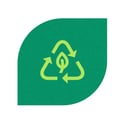The amount of plastic waste generated yearly is an astonishing 300 million metric tons. For comparison, that is roughly the weight of the entire human population. What’s worse, only a mere 10% of this plastic is recycled or reused according to Earth Day Network. Our planet is choking on plastic - we see it on the side of the road, piling up in landfills, and cluttering the oceans. Not only is it unsightly, but the CO2 emissions are adding to the growing problem of climate change and harming the natural environment. What’s the good news? Well, consumers are becoming more aware of this problem and companies are searching for more eco-friendly solutions to reduce their plastic waste. Continue reading to learn more about plastic packaging and tips for reducing your plastic waste.
Why is Plastic Packaging A Problem?
According to an article from the New York Times, the drastic increase of plastic waste in recent years has come from plastic packaging. Scientists estimate that in 2015, packaging consisted of 54% of nonfiber plastic that was thrown away. There can also be a hesitancy toward recycling plastic because you may not know which numbers are recyclable and which need to be tossed. We’ve put together a handy blog to help you understand how to read plastic numbers.
Here are three reasons why plastic packaging is such a problem:
 SINGLE-USE WASTE
SINGLE-USE WASTE
Around 80% of packaging is thrown away after only one use. That's a pretty small value considering the length of time it will stick around polluting the earth.
 IT'S NOT BIODEGRADABLE
IT'S NOT BIODEGRADABLE
Plastics take hundreds of years to decompose, meaning most of the plastic ever created is still around. Considering the fact that we create 300 million metric tons of plastic a year, this is cause for alarm.
 EXCESSIVE PACKAGING
EXCESSIVE PACKAGING
Companies often go overboard on the packaging. Have you ever received a product swimming in plastic? That’s a problem, and major companies like Amazon need to be actively searching for alternative solutions.
TIPS TO CUT DOWN ON PLASTIC PACKAGING
 Look for Sustainable packaging options
Look for Sustainable packaging options
Biodegradable packaging is becoming a popular option for companies looking to reduce their environmental impact. Biodegradable packaging means that once disposed of, the packaging will break down on its own after a short period of time. Compostable packaging is also a great way to divert waste from landfills and transform the packaging into nutrient-based soil. Lush is a great example of a company that limits its packaging and uses creative alternatives to plastic packaging.
 avoid over-ordering / order in bulk
avoid over-ordering / order in bulk
A great way to cut back on waste is to avoid over-ordering. The less you order, the less packaging is required. If you know you’ll repeatedly use a certain item, try buying in bulk when you can. Bulk orders typically require a lot less packaging than buying products individually.
 REUSABLE OPTIONS
REUSABLE OPTIONS
We're big advocates for reusables to cut out wasteful plastics. You would be surprised how much waste is reduced when you use reusable or refillable items (think, 365 disposable coffee cups, or 1 washable tumbler). Avoid retail coffee cups, plastic water bottles, plastic eating utensils, take-out containers, and unnecessary food packaging.
 Limit online shopping
Limit online shopping
As online shopping becomes more popular, the amount of packaging waste increases. Not only do our online orders require packaging, but the shipments tend to be "over-packaged" in large, wasteful boxes filled with unrecyclable plastic, packing peanuts, “styrofoam”, bubble wrap, etc. When you're able to shop for your items locally, you eliminate the need for all that wasteful packaging.
 TAKE THE LEAD
TAKE THE LEAD
Sometimes you need to take matters into your own hands! Simply getting in touch with businesses and expressing your desire to purchase items that are handled in eco-friendly ways is sometimes what it takes to make a change. A poll from Sealed Air, a packaging company, found that 66% of Americans believe that how their items are packaged represents how much the retailer cares about their order. When companies go the extra mile to be eco-friendly, customers perceive their brand as higher quality than those who don't.
Thank you for reading! We hope this inspires you to go green in your home and business. Please let us know in the comments below if you have any additional ways you cut out plastic packaging in your day-to-day. If you are a business and you want to implement better recycling practices, get in touch with a RoadRunner representative today!
